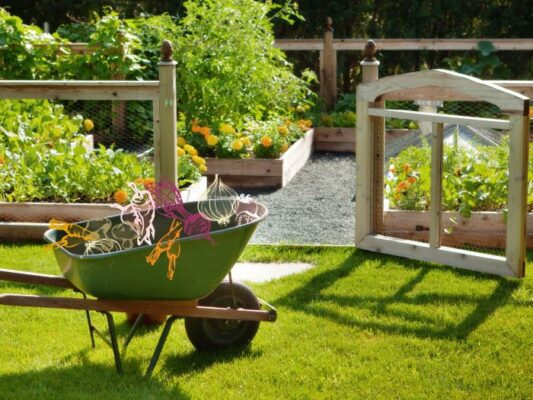Herb gardens are a great way for beginner gardeners to start growing their own food and spices. Figuring out the layout and design for a new herb garden can seem daunting, but with some simple planning, it can be easy and fun. In this article we talk about Herb Garden Layout Ideas for Beginners In 2024.
Table of Contents
Choose a Sunny Spot
When choosing where to locate your herb garden, sunlight is key. Most culinary herbs need at least 6 hours of direct sunlight per day. Choose the sunniest part of your yard or assess your space at different times of day before deciding on placement. South-facing spots against walls or fences make excellent herb garden locations. If sunlight is limited, focus on shade-tolerant herbs like mint, parsley, chives, oregano, and lemon balm.
Focus on Good Drainage
Herbs hate wet feet, so make sure your garden site has good drainage. Amend dense soils with compost or sand to improve drainage before planting. Or build a raised bed, which allows you to fill the frame with well-draining soil mix. Ensure any pots and containers also have holes at the bottom for drainage.
Keep It Close to the Kitchen
Herb gardens are designed for convenience, so they work best located close to your kitchen, either right outside the door or visible from a window. This way you can easily harvest fresh herbs to season meals or garnish plates. Having herbs within arm’s reach makes it more likely you’ll use them often in cooking.
Start Small
When planning an herb garden for the first time, it’s wise to start small. Limit yourself to 5-10 plants to begin with, then expand as your gardening knowledge grows. Popular first herbs include basil, thyme, rosemary, parsley, sage, mint, oregano, chives, and dill. Focus on herbs you love to cook with and don’t be afraid to experiment as you gain experience.
Consider Container Gardening
If space is limited, container gardening opens up opportunities to grow herbs on patios, balconies, doorsteps, or anywhere you have sunlight. Self-watering pots, window boxes, vertical gardens, hanging baskets, and decorative pots all work beautifully for herbs. Just ensure containers are at least 12 inches wide and deep for herb roots to establish.
Formal or Informal Designs
Herb garden layouts typically take an informal cottage style with curved borders, meandering paths, and herbs interplanted with flowers and vegetables. But you can also create formal herb gardens with straight lines, geometric patterns, boxes, borders, and pots with single species planted together. Play around with what design suits your space and tastes.
Borders and Pathways
Borders and pathways not only define the layout visually but allow you to access plants for tending and harvesting. Brick, stone, wood chips, gravel, and clover are great herb garden path materials. For borders, use bricks, rocks, wood, metal edging, or low boxwood hedges. Curving borders and paths create visual interest.
Raised Beds
Raised beds provide perfect growing conditions for herbs by improving drainage and soil quality. They also delineate garden space and make tending and harvesting easy, without having to bend down as far. Build your own from lumber, bricks, or rocks, or use pre-made frames. Include at least 12 inches of layered soil media, with compost or quality potting mix at the top for best growth.
Themed Zones
Consider grouping herbs together based on shared needs or uses, such as:
- Salad herbs (basil, chives, cilantro, dill, parsley)
- Pizza herbs (basil, oregano, rosemary, thyme)
- Tea herbs (chamomile, lemon balm, mint, stevia)
- Salsa herbs (cilantro, oregano, thyme)
- Nightshade herbs (chives, oregano, parsley, rosemary)
- Butterfly garden herbs (borage, chamomile, lavender, mint)
This zoning by use or culture creates organized beds that are easy to manage.
Companion Plantings
Many herbs grow well alongside vegetables and ornamental flowers. Try underplanting rosemary, thyme or sage around tomatoes, brassicas, squash or peppers. Allow dill, cilantro, and chives to dot a carrot or lettuce patch. Tuck lavender, nasturtiums, marigolds or petunias around the edges to add color. Taking cues from companion gardening guides when laying out your herb beds can lead to better plant health and productivity for all.
Use Vertical Space
Don’t limit your herb garden to flat ground. Utilize walls, trellises, fences and vertical structures to expand growing space. Train climbing herbs like hops, passionflower, jasmine or climbing roses on structures. Install wall-mounted planter boxes or hanging baskets for cascading herbs like nasturtium, strawberries, thyme, oregano or chamomile. Go vertical to boost yields in a small space.
Mind Maintenance
When laying out your herb garden, ensure you incorporate wide enough paths to access plants for maintenance and harvesting without damaging other plants. Space plants appropriately so they don’t compete for light and air flow once mature. Include room for amending soil, spreading mulch, staking tall plants, removing dead growth, and other gardening tasks. Planning these logistics will make upkeep much simpler.
Have Fun!
Designing an herb garden should be enjoyable! Don’t aim for perfection your first year. Get creative with the space you have and make changes each season as you expand. Part of the joy of gardening is learning as you grow, so embrace the process. With the right site prep and layout, your herb garden will soon thrive under your nurturing attention.
Conclusion
Creating an herb garden layout as a beginner gardener may seem challenging at first, but following simple design principles will set you up for success. Choose a sunny spot with good drainage that’s convenient to your kitchen for easy harvesting. Start small, incorporate structural elements like borders, paths and beds to define spaces, and don’t forget to have fun experimenting! With the framework in place, let your imagination run wild putting together an herb garden you’ll love tending, cooking from and relaxing in for years to come. I sincerely hope you find this “Herb Garden Layout Ideas for Beginners In 2024” article helpful.

